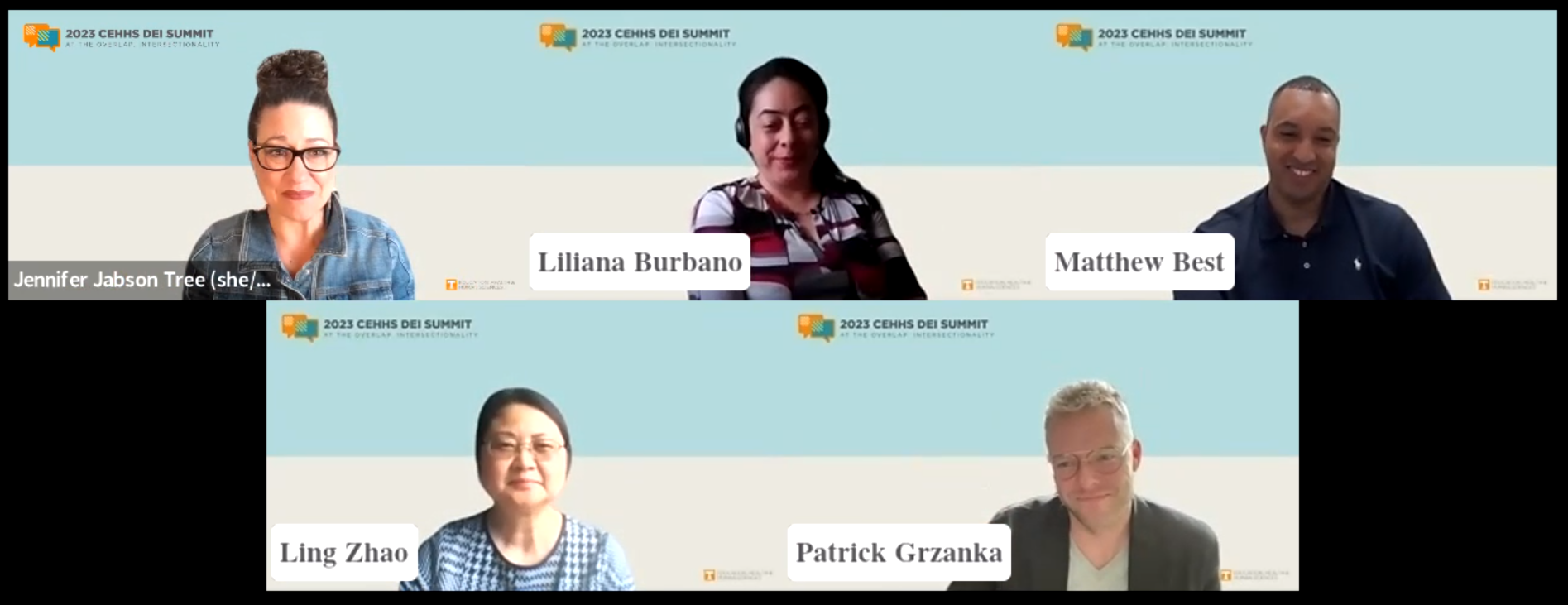Last Week Saw the Second Annual CEHHS DEI Summit, Themed “At the Overlap: Intersectionality”
By Macy Roberts, CEHHS Student Reporter, Class of 2024
Four events took place from April 10-14 with the purpose of fostering conversations about the impact multiple social identities bring to our community regarding students, faculty, staff and administrators in CEHHS’s Office of Diversity, Equity and Inclusion (DEI).
One event that took place during this year’s summit was a webinar titled “Navigating DEI During Contemporary Times,” in which a panel of scholars and community practitioners spoke about what intersectionality means to them and how it functions in their everyday lives.
The webinar was moderated by Jennifer Jabson Tree, an associate professor in the College of Education, Health and Human Sciences’ Department of Public Health.
Over the duration of the hour-long webinar, four panelists were asked how they incorporate the framework of intersectionality into their everyday actions; what opportunities and/or challenges are associated with applying an intersectional approach to DEI work; and what best practices they have for fostering inclusive, interpersonal dialogues on intersectionality with stakeholders.
Liliana Burbano, the Community Health Equity Director at UT Medical Center, described intersectionality as the place where “different forms of discrimination overlap.” She noted that healthcare professionals sometimes blame patients for what they endure rather than looking at how the systems that surround them bring them to where they are.
Burbano also identified how communities are often labeled based on what they lack, such as those lacking food security and those lacking access to transportation but said this does a disservice to those communities because they don’t primarily see themselves this way.
Furthermore, Burbano spoke on how race being a social construct fits into her understanding of intersectionality and her experience with DEI work as a Columbian immigrant.
“I don’t even know if I’m a woman of color. I don’t know what color I am … people assume that I should identify,” Burbano said.
Ling Zhao, a professor in the College of Education, Health, and Human Sciences’ Department of Nutrition, admitted that intersectionality is a new word to her. As a Chinese American, Zhao said she joined the webinar to generate awareness for Asian American Pacific Islander (AAPI) within DEI efforts.
Zhao noted how Asian Americans are often seen as the “model minority,” and on a personal level, she isn’t sure if this is a good or bad thing. However, Zhao said she was coming into the panel as someone with general knowledge about intersectionality with the goal of listening, learning, and examining her own biases.
Matthew Best, a Haslam College of Business alum and Executive Director of East Knoxville’s Change Center, spoke on how conversations about intersectionality and DEI often take an emotional toll on him. As a Black man, Best said he has experienced tokenism – that is, having been invited to conversations just for the sake of being there and checking a box.
“Truth telling is a hard thing because Western culture is conflict-avoidant,” Best said. “Half the time we can’t have conversations because we can’t agree on what truth is. We can at least agree on what something is before forming opinions on it.”
“You can’t just sit at the table with someone if you’re not willing to address harsh topics and understand their perspectives,” Patrick Grzanka, a professor in the College of Arts and Sciences’ Department of Psychology, added. “The term intersectionality scares people who don’t want to see justice and is seen as a dangerous concept.”
As professionals in their affiliated career fields, many of the panelists were also able to talk about how they can utilize their positions of influence in positive ways when it comes to encouraging intersectionality and DEI conversations in the workplace.
“If you’re in power, there are ways to be vulnerable so that you can set the tone for a conversation for others,” Best said.
Best identified DEI and cultural consciousness as a skill and recommended finding ways to displace or “other” yourself to try to understand other perspectives. Although, Burbano spoke to the importance of not grouping people together based on singular identities.
“Just because you share a characteristic with someone – like skin color – does not mean you have the same experiences,” Burbano said.
Burbano also provided the example of not calling people by the title “Dr.” but rather by their first names in environments when the title isn’t necessary, as it serves as an unnecessary element of power. By refraining from using a title with power, a more even and inclusive playing field is created.
Jabson Tree’s role as moderator meant she spent most of her time posing questions and guiding discussions among the panelists, but she also provided valuable insight and supporting ideas to what the panelists touched on.
“We think of discrimination as an interpersonal issue rather than a structural issue,” Jabson Tree said.
Miranda Rutan, a second-year doctoral student in CEHHS’s Higher Education Administration Program and the graduate research assistant for CEHHS DEI, said the primary goal of the summit is to educate and learn together.
“We focus on providing educational sessions for different types of learning with different focuses,” Rutan said.
These included virtual programs like Thursday’s webinar, as well as in-person sessions.
“We hope that the CEHHS community found one of our sessions helpful and added to their knowledge,” Rutan said.
